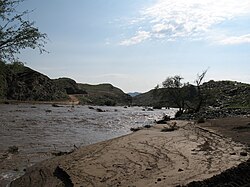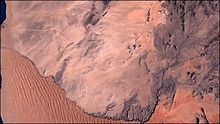
At 824,292 km2 (318,261 sq mi), Namibia is the world's thirty-fourth largest country. After Mongolia, Namibia is the second least densely populated country in the world. Namibia got its name from the Namib desert that stretches along the coast of the Atlantic. It is also known for its wildlife.

The Namib is a coastal desert in Southern Africa. According to the broadest definition, the Namib stretches for more than 2,000 kilometres (1,200 mi) along the Atlantic coasts of Angola, Namibia, and northwest South Africa, extending southward from the Carunjamba River in Angola, through Namibia and to the Olifants River in Western Cape, South Africa. The Namib's northernmost portion, which extends 450 kilometres (280 mi) from the Angola-Namibia border, is known as Moçâmedes Desert, while its southern portion approaches the neighboring Kalahari Desert. From the Atlantic coast eastward, the Namib gradually ascends in elevation, reaching up to 200 kilometres (120 mi) inland to the foot of the Great Escarpment. Annual precipitation ranges from 2 millimetres (0.079 in) in the aridest regions to 200 millimetres (7.9 in) at the escarpment, making the Namib the only true desert in southern Africa. Having endured arid or semi-arid conditions for roughly 55–80 million years, the Namib may be the oldest desert in the world and contains some of the world's driest regions, with only western South America's Atacama Desert to challenge it for age and aridity benchmarks.

The Namib-Naukluft Park is a national park in western Namibia, situated between the coast of the Atlantic Ocean and the edge of the Great Escarpment. It encompasses part of the Namib Desert, the Naukluft mountain range, and the lagoon at Sandwich Harbour. The best-known area of the park and one of the main visitor attractions in Namibia is Sossusvlei, a clay pan surrounded by dunes, and Sesriem, a small canyon of the Tsauchab. The desert research station of Gobabeb is situated within the park.

Solitaire is a small settlement in the Khomas Region of central Namibia near the Namib-Naukluft National Park. It currently features the only gasoline station, bakery, cafe, and the only general dealer between the dunes at Sossusvlei and the coast at Walvis Bay, as well as on the road to the capital Windhoek. Solitaire belongs to the Windhoek Rural electoral constituency.
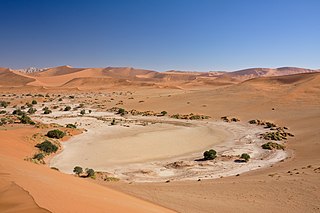
Sossusvlei is a salt and clay pan surrounded by high red dunes, located in the southern part of the Namib Desert, in the Namib-Naukluft National Park of Namibia. The name "Sossusvlei" is often used in an extended meaning to refer to the surrounding area. These landmarks are some of the major visitor attractions of Namibia.

The Swakop River is a major river in western central Namibia. Its source is in the Khomas Highland. From there it flows westwards through the town of Okahandja, the historic mission station at Gross Barmen, and the settlement of Otjimbingwe. It then crosses the Namib desert and reaches the Atlantic Ocean at Swakopmund. The Swakop is an ephemeral river; its run-off is roughly 40 million cubic metres per annum.

The Tsauchab is an ephemeral river in the Hardap Region of central Namibia. Its source is in the southern Naukluft Mountains, from where it flows westwards through the Namib-Naukluft National Park into Sossusvlei, an endorheic basin. The lower river has in the past had a slightly different courses and also formed two other basins, the Deadvlei and the Hiddenvlei.
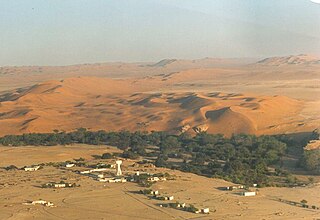
The Gobabeb Namib Research Institute, short: Gobabeb, is a centre for dry land training and research in Namibia. It is located in the Namib Desert, 120 kilometres (75 mi) south-east of Walvis Bay.

Tourism in Namibia is a major industry, contributing N$7.2 billion to the country's gross domestic product. Annually, over one million travelers visit Namibia, with roughly one in three coming from South Africa, then Germany and finally the United Kingdom, Italy and France. The country is among the prime destinations in Africa and is known for ecotourism which features Namibia's extensive wildlife.
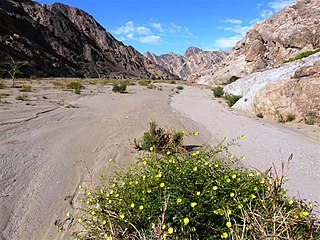
The river Khan is an ephemeral river crossing the Erongo region of central Namibia. It is the main tributary of the Swakop River and only occasionally carries surface water during the rainy season from November to February/March. Khan's catchment area including its tributaries Slang and Etiro stretches over 8,400 square kilometres (3,200 sq mi).
Henno Martin was a German professor of geology who, along with Hermann Korn, lived for two years in the Namib Desert to avoid internment during the Second World War.
Acanthoproctus diadematus is an armoured katydid, bush-cricket, or ground cricket endemic to the Namib Desert of southern Africa, where it lives in the tall sand dunes along the Kuiseb River in Namib-Naukluft National Park. The katydid feeds on the !nara melon endemic to the area.

The Omaruru River is a major river crossing the Erongo Region of western central Namibia from East to West. It originates in the Etjo Mountains, crosses the town of Omaruru and the village of Okombahe, and reaches the sea a few kilometers north of Henties Bay. Inflows of the Omaruru are Otjimakuru, Goab, Spitzkop, Leeu and Okandjou.
Utuseb is a small settlement in the Erongo Region in western central Namibia. It is situated in the Namib Desert, approximately 40 kilometres (25 mi) from Walvis Bay on the banks of Kuiseb River. Utuseb has approximately 700 inhabitants and belongs to the Walvis Bay Rural electoral constituency. The people living here belong to the ǂAonin community, a subtribe of the Nama people.

The Hoanib is one of the 12 ephemeral seasonal rivers in the west of Namibia, where it used to be the border between northern Damaraland and Kaokoland. Its length is 270 km. With the low population density in the area, the oasis character of the river valley and the relatively high wildlife population of the Hoanib, like in the case of the Hoarusib, its valley is one of the last true wilderness areas in Namibia. One of the last settlements of desert elephants, it is characterised by strong wind and water eroded, weathered stone deposits. Inflows of Hoanib are Aap River, Otjitaimo River, Ombonde, Ganamub, Mudorib and Tsuxub.
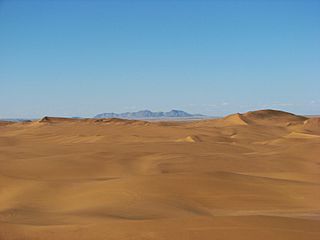
The Dorob National Park is a protected area in the Erongo region, along the central Namibian coast, which is 1,600 kilometres (990 mi) in length. It was gazetted as a national park under the Nature Conservation Ordinance No.4 of 1975 on 1 December 2010, and with Namib-Naukluft Park it covers an area of 107,540 square kilometres (41,520 sq mi).
The Topnaar people (ǂAonin) are a clan of the Nama people in Namibia. Their settlements are all situated on the Kuiseb River in the Erongo Region of central Namibia, the largest one is Utuseb.
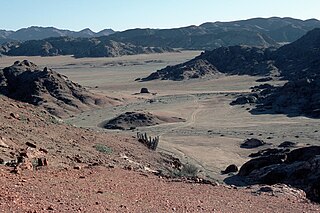
The river Khumib is an ephemeral river crossing the Kunene Region of north-western Namibia. It occasionally carries surface water during the rainy seasons in November and February/March. Its catchment area is estimated between 2200 and 2,300 square kilometres (890 sq mi).

The Huab River is an ephemeral river in the Kunene Region of north-western Namibia. Its source is southeast of Kamanjab, from where it flows westwards through Mopane savanna until it reaches the Skeleton Coast and the Atlantic Ocean. Inflows of the Huab are Klein-Omaruru, Sout, Aba-Huab, Ongwati and Klip. Huab's catchment area is estimated to be between 14,800 and 16,465 km2 (6,357 sq mi), and includes the town of Khorixas as well as the settlements Kamanjab, Fransfontein, and Anker. The Twyfelfontein World Heritage Site is located on the banks of the Aba Huab.

The Tsondab River is an ephemeral river in the Hardap Region of central Namibia. Its source is in the Remhoogte Mountains. From there it flows westwards through the Namib-Naukluft National Park before evaporating at Tsondabvlei. Inflows of the Tsondab are Diep, Noab and Koireb. Tsondab's catchment area is 3,500 km2 (1,400 sq mi).
